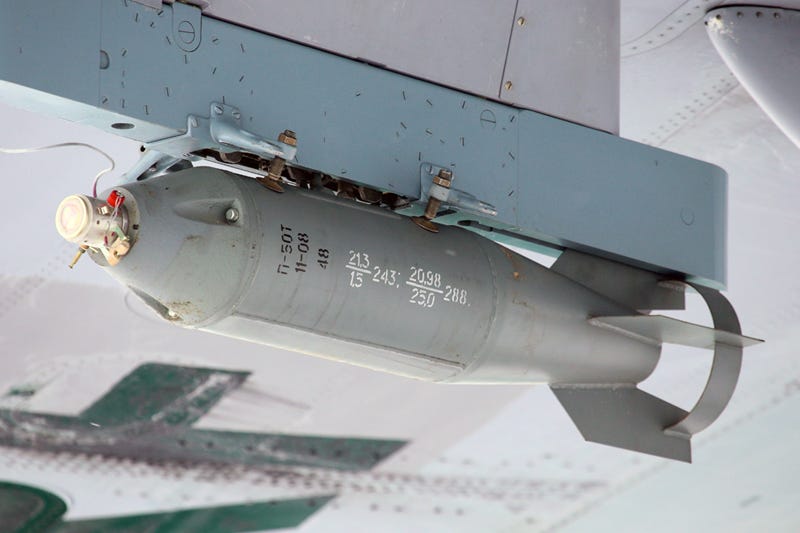by MATTHEW GAULT
Moscow plans to base the strike aircraft near the Baltic
On Jan. 30, the Russian aviation manufacturer Ilyushin announced a very strange test. According to the company, the Russian military strapped bombs to an Il-76MD—a cargo plane—to test its capabilities … as a bomber.
In all, the Russian air force plans to station 10 crews trained in rigging bombs to the lumbering transports in the Tver, Orenburg, Pskov and Taganrog areas of Russia. Which is telling—it’s all part of the Kremlin’s growing military build-up along its periphery.
Orenburg is in the interior of the country, near the border of Kazakhstan. Tver, Pskov and Taganrog are all near the Baltic. Taganrog sits on the Sea of Azov, just two hours south of Donetsk. Pskov is only an hour’s drive from Estonia and Latvia.
The idea is to fly the Il-76s into unfamiliar territories, inspect the ground using flares, drop bombs to clear a path, then land and unload troops. The planes would fly at 300 miles per hour at an altitude between 1,500 and 3,000 feet.
“The task of the pilots is to carry out autonomous landing in an unprepared and unfamiliar area in the rear of the simulated enemy,” Russian air force colonel Igor Klimov told the Interfax news agency.
The plan is strange, that Moscow would use this plane to enact it is not.
The Il-76MD is large and heavy, weighing in at more than 100 tons when empty, and upwards of 200 tons when full. It can carry a lot of troops. Depending on the arrangement, the airlifter can fit 225 soldiers inside.
Russia has used the Il-76 to move troops since the 1970s, and still relies on the plane to rush airborne troops into conflicts, including during the 2014 invasion of Crimea.
 This particular variant of the Il-76—the MD—is well suited for military engagements. It has heavier armor, includes four hard points and two 23-millimeter cannons in the tail. During recent tests, the Il-76s dropped at least 30 practice bombs, some weighing 500 pounds, according to Russian media reports.
This particular variant of the Il-76—the MD—is well suited for military engagements. It has heavier armor, includes four hard points and two 23-millimeter cannons in the tail. During recent tests, the Il-76s dropped at least 30 practice bombs, some weighing 500 pounds, according to Russian media reports.
Above—a crew preparing the P-50T practice bombs for the test. Ilyushin photo. At top—an IL-76 mobile hospital. Kirill Naumenko photo via Wikimedia commons
 Air forces all over the world have long modified cargo planes for war. The German Luftwaffe bombed Poland with Ju-52 transports during World War II. Vietnam attacked Cambodia with pallets of explosives thrown from the back of C-130s captured after the fall of Saigon.
Air forces all over the world have long modified cargo planes for war. The German Luftwaffe bombed Poland with Ju-52 transports during World War II. Vietnam attacked Cambodia with pallets of explosives thrown from the back of C-130s captured after the fall of Saigon.
The Syrian air force has dropped barrel bombs from transport planes at high altitude. It’s an indiscriminate and brutal method of warfare.
The idea of arming troop carriers for intense combat isn’t new, either. The U.S. Air Force has AC-130 gunship variants packing cannons and small-diameter bombs.
But there’s a chance Russia’s low-flying bombing strategy is too risky to be practical. For one, the Il-76’s bombs are unguided. Pilots would need to get close to a target, mark it with flares and drop them from medium altitude, all while potentially taking fire.
It’s a role traditionally assigned to gunships or dedicated attack planes, both of which Russia has. In the event it’s used beyond Russia’s borders, there’s a good chance anti-aircraft weapons could shoot the Il-76s down before they have a chance to drop troops, bombs or even the flares.
 The cargo planes would be most effective in so-called “permissive” airspace. That is, where nobody shoots back.
The cargo planes would be most effective in so-called “permissive” airspace. That is, where nobody shoots back.
The Russian military has spent a lot of cash and time modernizing its air force. It’s possible outfitting the Il-76 is a cost-saving measure that allows Moscow to keep the older planes in the air.
 The Russian economy is still reeling from plunging gas prices and Western sanctions. Putin has vowed not to cut military spending, despite cautions from his finance minister.
The Russian economy is still reeling from plunging gas prices and Western sanctions. Putin has vowed not to cut military spending, despite cautions from his finance minister.
Moscow wants more troops and arms along its western border. It wants to show NATO that it won’t back down from a fight, and that it has the capability to meet force with force. But it might not have the funds to do that.
If so, the Russian air force could be making due with what it has—transport planes designed in the ’70s and fitted with bombs. A dangerous gambit that could kill more Russian soldiers than it ever deploys.
No comments:
Post a Comment